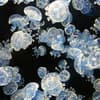Survey of Fungi PDF
Document Details

Uploaded by RapturousGyrolite5789
Tags
Summary
This document provides an overview of fungi, including their characteristics, diversity, and different types. It covers various fungal groups, their roles, and their symbiotic relationships. It also explains fungal structure and reproduction.
Full Transcript
survey of fungi OVERVIEW OF FUNGI fungi are part of opisthokonts (part of supergroup Unikonta) eukaryotic heterotrophs cell wall composed of chitin can be single celled (yeasts) or multicellular...
survey of fungi OVERVIEW OF FUNGI fungi are part of opisthokonts (part of supergroup Unikonta) eukaryotic heterotrophs cell wall composed of chitin can be single celled (yeasts) or multicellular (molds/mushrooms) absorptive heterotrophs: organisms that secrete digestive enzymes into substrate absorb the digested molecules via active transport hyphae: think filaments of cytoplasm & nuclei maximize surface area septa: cells by cross walls; have pores that allow for movement of cellular components (ribosomes or mitochondria) haustoria: specialized hyphae that can grow into other organisms to exchange/collect nutrients mycelium: collection of hyphae that forms the main body of a fungus fungi have both sexual and asexual phases caused by many nuclei traveling between cells dikaryotic: brief diploid phase where two different mating type cells combine cytoplasm (plasmogamy) but nuclei do not survey of fungi 1 fuse karyogamy: nuclei fuse and diploid cell is made undergo meiosis to form diverse spores that can be distributed asexual reproduction through spores (budding) through fragmentation abundant; can quickly colonize ephemeral food sources FUNGAL DIVERSITY OVERVIEW all phyla share general fungal characteristics absorptive heterotrophs cell walls composed of chitin groups differentiated based on flagellated spores or non flagellated survey of fungi 2 CHYTRIDS fungi are usually aquatic; are saprobes saprobes: consume dead organic material (decomposers) can be single celled or multicellular responsible for the infections on amphibian populations ZOOPAGOMYCETES formerly combined with Mucoromycetes large portion are endoparasites (live within animal hosts) example - Entomophthora controls flies to climb vegetation for optimal spore dispersal survey of fungi 3 MUCOROMYCETES bread molds fungi mainly coenocytic saprotrophs fuzzy filamentous appearance (mold on food) can be parasitic or commensal zygosporangia: large, dark thick walled structures where karyogamy and meiosis occur can develop into a stalk to disperse spores GLOMEROMYCETES mycorrhizae: symbiotic associations between fungi and plant roots increase surface area in the roots for nutrient & water uptake ectomycorrhizal: fungi grown on top of plant roots; establish connections between plant cells arbuscular: fungi grown directly into the tissues survey of fungi 4 of the roots plant supplies fungus with biomolecules (carbohydrates & amino acids) mycorrhizae plants grow faster/larger do not reproduce sexually (no fruiting bodies) have coenocytic hyphae (not divided into compartments; one long cell) obligate symbionts: organisms dependent on another for survival glomeromycetes dependent on plants for survival ASCOMYCETES asci: cup like or sac shaped reproductive structures includes yeasts, some molds, morels, and truffles examples - cordyceps, penicillin conidia: spores of ascomycetes on conidiophores (modified hyphae) reproduce asexually lichens: symbiotic association of 3 organisms 1. water and nutrient absorption 2. photosynthesizing capabilities 3. protection allows fungi to colonize wide range of areas survey of fungi 5 3 types of lichen FOLIOSE CRUSTOSE FRUTICOSE BASIDIOMYCETES known as club fungi includes puffballs and shelf pathogenic rusts & smuts basidium: sexual reproductive structure that produces spores found within basidiocarp gills (fruiting body/mushroom) FUNGAL STRUCTURE MOLD BODY composed of filamentous mycelium requires penetration into growth substrate survey of fungi 6 MUSHROOM BODY fruiting body of fungi produces spores main body (mycelium) is located below the ground displays filamentous growth pattern survey of fungi 7